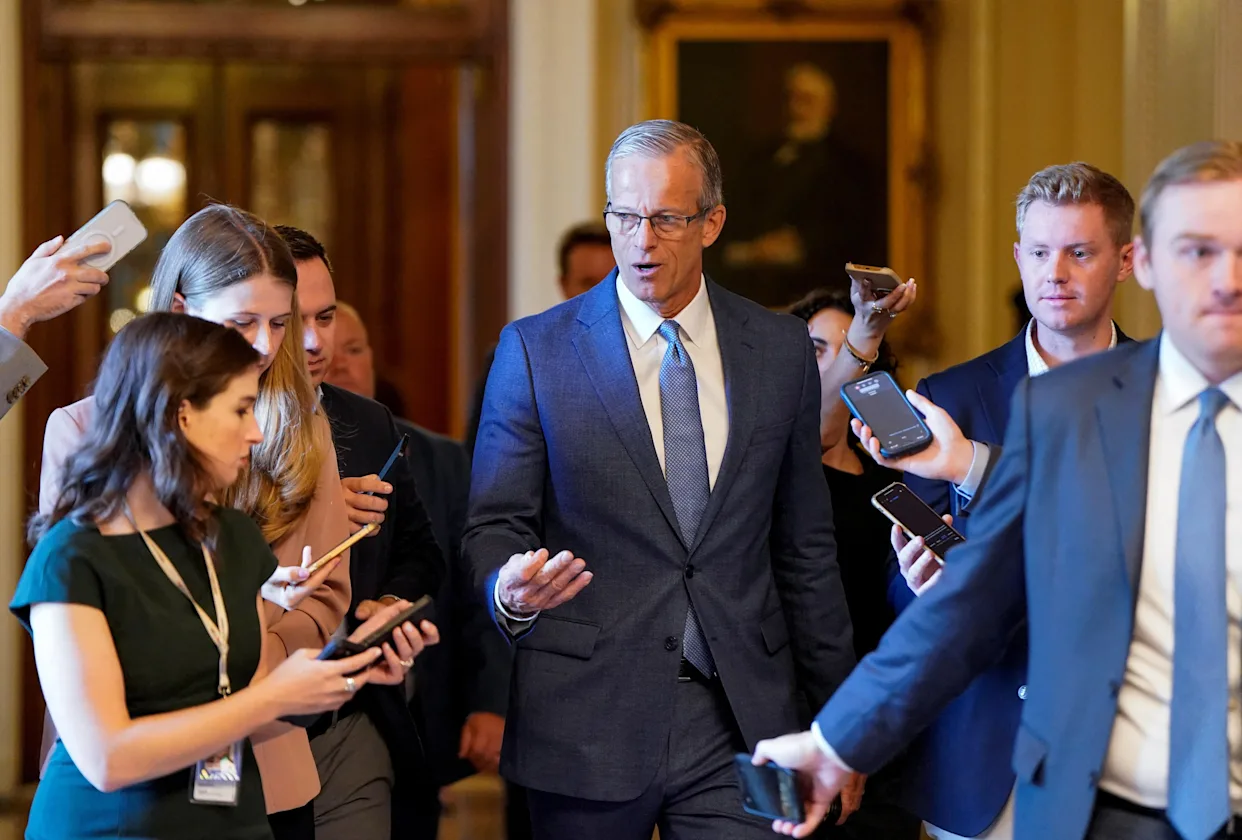The United States Senate is currently embroiled in a high-stakes, marathon voting session on a sweeping budget bill, colloquially dubbed the “One Big Beautiful Bill Act” by President Donald Trump. This legislation is a cornerstone of the Trump administration’s agenda, aiming to reshape the nation’s fiscal policy through extensive tax breaks and significant cuts to welfare programs. However, its passage hangs precariously in the balance, challenged by deep divisions within the Republican Party and fierce opposition from Democrats, all under the looming deadline of July 4.
The legislative drama unfolding on Capitol Hill highlights the intense ideological battles defining contemporary American politics. With the bill spanning nearly a thousand pages, senators are engaged in a grueling “vote-a-rama,” a process that could extend for up to 20 hours, as amendments are proposed, debated, and voted upon. The outcome of this session is not just a procedural formality; it carries profound implications for millions of Americans, the national debt, and the political future of the country.
The “One Big Beautiful Bill Act”: A Vision for America’s Economy
At its core, the “One Big Beautiful Bill Act” embodies President Trump’s long-standing economic philosophy: a belief that substantial tax reductions, particularly for corporations and high-income earners, will stimulate economic growth, create jobs, and ultimately benefit all Americans. The bill proposes to extend an estimated $3.8 trillion in tax breaks, largely stemming from earlier legislation passed during the Trump administration. Proponents argue these cuts incentivize investment, encourage businesses to expand, and keep more money in the pockets of taxpayers, thereby boosting overall economic activity. They contend that a more robust private sector will naturally lead to prosperity that trickles down through society.
However, critics, primarily Democrats and some fiscal conservatives, argue that these tax breaks disproportionately benefit the wealthy and large corporations, while contributing significantly to the national debt. They point to the projected $3.3 trillion increase to the national debt as a direct consequence of these fiscal policies, raising concerns about intergenerational equity and the nation’s long-term financial stability.
The other major component of the bill involves substantial cuts to welfare programs. While specific details can shift during the legislative process, the general intent is to reduce government spending on social safety nets. This aspect has ignited intense debate, with Democrats vehemently opposing any measures that could harm vulnerable populations.
The Legislative Gauntlet: Understanding “Vote-a-Rama”
The “vote-a-rama” is a unique and often exhausting feature of the U.S. Senate’s budget reconciliation process. It is a continuous series of votes on amendments to a budget resolution or a reconciliation bill, with little to no debate permitted on each individual amendment. This procedural marathon is designed to allow senators to offer amendments without the usual time constraints, but it often results in a flurry of votes that can last for many hours, sometimes through the night.
For the party in power, it’s a test of discipline and unity, as they try to fend off amendments that could derail their agenda. For the minority party, it’s a strategic opportunity to:
- Force politically difficult votes: By offering amendments on controversial topics (e.g., specific spending cuts, environmental protections, social issues), the minority can force members of the majority party to take public stances that might be unpopular with their constituents.
- Highlight policy differences: It allows the minority to draw a stark contrast between their priorities and those of the majority, framing the debate for public consumption.
- Delay and fatigue: While not always the primary goal, the sheer length of a vote-a-rama can wear down senators and potentially lead to mistakes or unexpected outcomes.
A recent example of a stalling tactic employed by Democrats was their demand for Senate clerks to read all 940 pages of the bill aloud. This maneuver, while permitted by Senate rules, is rarely invoked due to its time-consuming nature. In this instance, it took a remarkable 16 hours, effectively delaying the bill’s progress and drawing national attention to its immense length and complexity. Democrats used this tactic to emphasize that such a far-reaching piece of legislation should not be rushed through without proper scrutiny, forcing a public reckoning with the bill’s contents.
Key Contentions: Tax Cuts vs. Welfare Cuts and the Mounting Debt
The core of the legislative battle revolves around the proposed extension of $3.8 trillion in Trump-era tax breaks and the corresponding cuts to welfare programs.
The Tax Break Debate: Fueling Growth or Debt?
The tax cuts, initially enacted in previous years, were championed by the Trump administration as a means to stimulate the economy. Proponents argue that lower corporate and individual tax rates encourage businesses to invest more, hire more workers, and keep their operations within the United States. They also suggest that individuals, with more disposable income, will spend and invest more, further boosting economic activity. The argument is that these measures foster a more competitive business environment globally.
However, critics contend that the primary beneficiaries of these tax breaks are large corporations and the wealthiest segments of the population, leading to increased income inequality. Furthermore, the non-partisan Congressional Budget Office (CBO) has consistently projected that these tax cuts, without corresponding revenue increases or spending reductions, will significantly add to the national debt.
Welfare Program Cuts: The Human Cost
The proposed reductions in welfare programs are the most contentious aspect of the bill, particularly the potential impact on healthcare. Senator Rick Scott’s amendment, for instance, has drawn widespread condemnation for its potential to cause roughly 20 million Americans to lose their health insurance coverage.
Medicaid, a joint federal and state program, provides health coverage to millions of low-income Americans, including children, pregnant women, elderly adults, and people with disabilities. It is a critical safety net for the nation’s most vulnerable populations. Cuts to Medicaid could lead to:
- Reduced access to care: Millions losing coverage would face significant barriers to obtaining necessary medical services, prescription drugs, and preventative care.
- Increased burden on states: States would either have to increase their own funding to maintain services or cut back, potentially leading to a patchwork of coverage across the country.
- Strain on healthcare providers: Hospitals and clinics might see an increase in uninsured patients, leading to more uncompensated care and financial strain on the healthcare system.
Senate Majority Leader John Thune attempted to downplay the immediate impact of Scott’s amendment, arguing that it “doesn’t take effect until 2031.” However, Democrats and healthcare advocates counter that a delayed effective date does not negate the devastating long-term consequences for millions of families who rely on this vital program. The debate underscores a fundamental philosophical divide over the role of government in providing social safety nets.
Beyond Medicaid, other unspecified welfare programs could also face cuts, potentially impacting housing assistance, food security, and other essential services for low-income families.
The Soaring National Debt: A Looming Crisis?
The national debt currently stands at a staggering $36 trillion, according to the Treasury Department. The “One Big Beautiful Bill Act,” if passed, is estimated to add another $3.3 trillion to this figure. This projected increase fuels concerns among fiscal hawks and economists about the nation’s long-term financial health.
A rapidly expanding national debt has several implications:
- Increased interest payments: A larger debt means more taxpayer money must be allocated to paying interest, diverting funds from other critical areas like infrastructure, education, or research.
- Reduced fiscal flexibility: High debt levels can limit the government’s ability to respond to future economic downturns, national emergencies, or unforeseen crises.
- Intergenerational burden: Future generations will bear the brunt of paying off the accumulated debt, potentially facing higher taxes or reduced public services.
- Impact on economic growth: While some argue that debt-financed spending can stimulate growth, excessive debt can lead to higher interest rates, crowding out private investment and potentially stifling long-term economic expansion.
The debate over the national debt highlights the tension between short-term political goals and long-term fiscal responsibility, a recurring theme in Washington.
Republican Divisions: A Fragile Majority
Despite controlling both chambers of Congress, Republicans are far from unified on the “One Big Beautiful Bill Act.” The party’s slim majority in the Senate (51-49) means they can only afford three defections for the bill to pass without the need for Vice-President JD Vance to cast a tie-breaking vote. This narrow margin has empowered individual senators to wield significant influence, leading to fraught negotiations.
One prominent voice of dissent came from North Carolina Senator Thom Tillis, who announced his retirement following his vote against opening debate on the bill. Tillis publicly criticized the legislation, stating it “broke promises that Trump and Republicans made to voters” and lamenting that “too many elected officials are motivated by pure raw politics who really don’t give a damn about the people they promised to represent on the campaign trail.” This scathing critique from within the party highlights the internal struggle between fiscal conservatism and political expediency. The White House, through Press Secretary Karoline Leavitt, reacted angrily to Tillis’s comments, dismissing them as “just wrong.”
Another notable Republican objecting to the bill is Kentucky Senator Rand Paul, who has consistently raised concerns about the debt increase and the proposed cuts to Medicaid. His libertarian-leaning fiscal conservatism puts him at odds with parts of the party’s spending agenda.
The divisions extend to the House of Representatives, where the Republican-led House Freedom Caucus, a group of influential fiscal conservatives, has threatened to “torpedo” the Senate version of the bill. They argue that the Senate proposal, which adds over $650 billion to the national deficit, is “not fiscal responsibility” and does not align with their agreed-upon principles. This intra-party friction could lead to further legislative hurdles even if the bill clears the Senate, potentially requiring another round of negotiations and votes.
Democratic Opposition: A United Front
In stark contrast to the Republican infighting, Democrats have largely presented a united front against the “One Big Beautiful Bill Act.” Their objections are rooted in fundamental disagreements over the bill’s priorities:
- Cuts to health insurance: Democrats consistently highlight the potential for millions of Americans, particularly the poor and vulnerable, to lose health coverage due to Medicaid cuts.
- Tax breaks for the wealthy: They argue that extending $3.8 trillion in tax breaks primarily benefits the rich and corporations at the expense of working families.
- Increased national debt: Democrats echo concerns about the escalating national debt and its long-term implications for the country.
Senator Adam Schiff, a prominent Democrat, called the bill “terrible” and expressed skepticism about the Republican leadership’s ability to meet President Trump’s July 4th deadline. Democrats have also employed strategic legislative tactics to draw attention to their concerns, such as the 16-hour reading of the nearly 1,000-page bill aloud in the Senate. This highly unusual maneuver, while permitted by Senate rules, was a clear signal of their intent to delay and highlight the bill’s complexity and the perceived lack of transparency in its rapid progression.
Elon Musk’s Intervention: A High-Profile Critic Weighs In
Adding another layer of intrigue to the legislative battle is the outspoken criticism from tech mogul Elon Musk, a former close ally of President Trump. Musk has repeatedly condemned the bill, labeling it “insane” and even threatening to establish a new political party. His high-profile interventions, often via his social media platform, inject a unique dynamic into the political discourse, reaching an audience beyond traditional political news consumers.
President Trump, never one to shy away from a public spat, quickly retaliated on his Truth Social platform. He suggested that the so-called Department of Government Efficiency (Doge) – a playful jab at Musk’s past association with the meme cryptocurrency Dogecoin, and likely a reference to Musk’s previous advisory role in the Trump administration – should investigate the subsidies received by Musk’s companies, particularly Tesla and SpaceX. Trump asserted that “Elon may get more subsidy than any human being in history, by far, and without subsidies, Elon would probably have to close up shop and head back home to South Africa.”
This exchange highlights a perceived irony by some critics: while Musk often advocates for free markets and criticizes government spending, his own ventures, particularly in renewable energy (Tesla) and space exploration (SpaceX), have significantly benefited from government contracts, tax credits, and subsidies. For example, Tesla received billions in government support through various programs aimed at promoting electric vehicles and renewable energy. SpaceX, similarly, has secured lucrative contracts from NASA and the Department of Defense, which have been crucial to its development and success. Trump’s comments, therefore, tap into a broader debate about corporate welfare and the role of government incentives in fostering innovation and industry growth.
Musk’s continued criticism, despite his past ties to the administration, underscores the deep divisions that even prominent figures can have over fiscal policy and government spending. His threat to form a new political party, while perhaps more rhetorical than a concrete plan, reflects a growing dissatisfaction among some segments of the population with both major political parties.
Political Stakes and Future Implications
The stakes for President Trump and the Republican Party are exceptionally high. Passing this bill by the July 4th deadline would represent a significant legislative victory, allowing the administration to claim fulfillment of key campaign promises regarding tax cuts and reduced government spending. It would provide momentum heading into future election cycles.
However, failure to pass the bill, or its passage with significant compromises that alienate key factions, could expose deep rifts within the Republican Party and signal a struggle to enact their agenda even with control of Congress. This could have repercussions for party unity and future legislative efforts.
For Democrats, successfully blocking or significantly altering the bill would be a major win, allowing them to portray themselves as defenders of social safety nets and fiscal responsibility against what they view as reckless tax cuts for the rich.
The outcome of this marathon vote will not only shape immediate policy but also influence the broader political narrative, setting the stage for future legislative battles and potentially impacting the upcoming election landscape. The intense partisan struggle over this bill is a microcosm of the current political climate in the United States, characterized by deep ideological divides and high-stakes legislative showdowns.
Conclusion: A Nation Divided on Fiscal Future
As the US Senate endures its “vote-a-rama” on the “One Big Beautiful Bill Act,” the profound divisions within American politics are on full display. The legislation, a central pillar of President Trump’s agenda, seeks to extend significant tax breaks while implementing welfare program cuts, policies that have ignited fervent debate across the political spectrum.
The potential loss of health insurance for millions of Americans, coupled with a projected multi-trillion-dollar increase to the national debt, underscores the immense human and fiscal implications of this bill. Republican unity remains fragile, with key senators voicing strong objections, while Democrats stand firm in their opposition, employing every legislative tool to highlight their concerns. Even high-profile figures like Elon Musk have weighed in, adding to the public discourse and revealing the complex interplay between business, technology, and politics.
Regardless of its immediate fate, this marathon vote serves as a stark reminder of the deep ideological chasm that defines America’s approach to its economic and social future. The path forward for the nation’s fiscal policy will undoubtedly remain a battleground, with the outcomes of such legislative showdowns shaping the lives of its citizens for years to come.
Ready to take your career to the next level? Join our dynamic courses: ACCA, HESI A2, ATI TEAS 7 , HESI EXIT , NCLEX – RN and NCLEX – PN, Financial Literacy!🌟 Dive into a world of opportunities and empower yourself for success. Explore more at Serrari Ed and start your exciting journey today! ✨
photo source: Google
By: Montel Kamau
Serrari Financial Analyst
1st July, 2025
Article, Financial and News Disclaimer
The Value of a Financial Advisor
While this article offers valuable insights, it is essential to recognize that personal finance can be highly complex and unique to each individual. A financial advisor provides professional expertise and personalized guidance to help you make well-informed decisions tailored to your specific circumstances and goals.
Beyond offering knowledge, a financial advisor serves as a trusted partner to help you stay disciplined, avoid common pitfalls, and remain focused on your long-term objectives. Their perspective and experience can complement your own efforts, enhancing your financial well-being and ensuring a more confident approach to managing your finances.
Disclaimer: This article is for informational purposes only and does not constitute financial advice. Readers are encouraged to consult a licensed financial advisor to obtain guidance specific to their financial situation.
Article and News Disclaimer
The information provided on www.serrarigroup.com is for general informational purposes only. While we strive to keep the information up to date and accurate, we make no representations or warranties of any kind, express or implied, about the completeness, accuracy, reliability, suitability, or availability with respect to the website or the information, products, services, or related graphics contained on the website for any purpose. Any reliance you place on such information is therefore strictly at your own risk.
www.serrarigroup.com is not responsible for any errors or omissions, or for the results obtained from the use of this information. All information on the website is provided on an as-is basis, with no guarantee of completeness, accuracy, timeliness, or of the results obtained from the use of this information, and without warranty of any kind, express or implied, including but not limited to warranties of performance, merchantability, and fitness for a particular purpose.
In no event will www.serrarigroup.com be liable to you or anyone else for any decision made or action taken in reliance on the information provided on the website or for any consequential, special, or similar damages, even if advised of the possibility of such damages.
The articles, news, and information presented on www.serrarigroup.com reflect the opinions of the respective authors and contributors and do not necessarily represent the views of the website or its management. Any views or opinions expressed are solely those of the individual authors and do not represent the website's views or opinions as a whole.
The content on www.serrarigroup.com may include links to external websites, which are provided for convenience and informational purposes only. We have no control over the nature, content, and availability of those sites. The inclusion of any links does not necessarily imply a recommendation or endorsement of the views expressed within them.
Every effort is made to keep the website up and running smoothly. However, www.serrarigroup.com takes no responsibility for, and will not be liable for, the website being temporarily unavailable due to technical issues beyond our control.
Please note that laws, regulations, and information can change rapidly, and we advise you to conduct further research and seek professional advice when necessary.
By using www.serrarigroup.com, you agree to this disclaimer and its terms. If you do not agree with this disclaimer, please do not use the website.
www.serrarigroup.com, reserves the right to update, modify, or remove any part of this disclaimer without prior notice. It is your responsibility to review this disclaimer periodically for changes.
Serrari Group 2025












